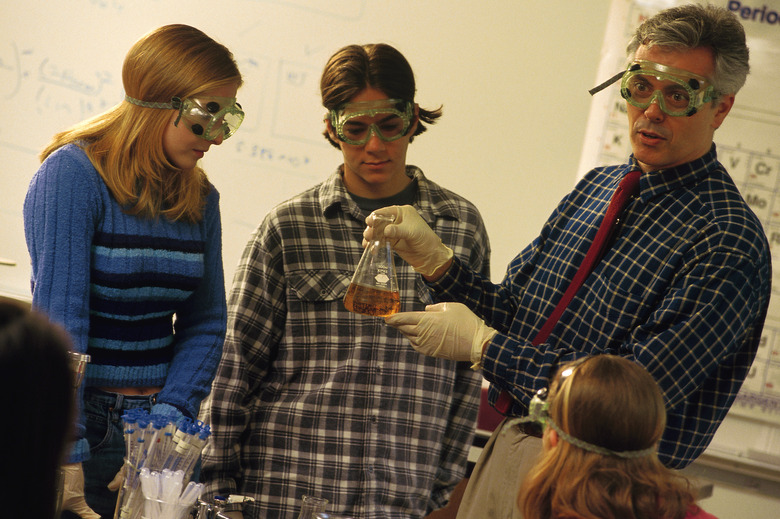Five Ways To See Chemical Reactions
A chemical reaction occurs when two or more materials interact and transform into new substances. For instance, when water is mixed with baking soda, the molecules in the two reactants produce sodium hydroxide and fizzing carbonic acid. The fizz from the carbonation demonstrates an empirically observable chemical reaction. Scientists use instruments such as mass spectrometers to detect chemical reactions not always visible to the eye.
Bright Lights
Bright Lights
Light is a byproduct of some chemical reactions. Often both heat and light are produced, as illustrated by the hot, glowing flame on a candle. Chemiluminescent reactions only generate light. Novelty items like light sticks and children's glowing bracelets are examples of chemiluminescent reactions. Bending and shaking the object causes chemicals inside to react and produce light. Emission of light by bioluminescent organisms is a type of a naturally occurring chemical reaction seen in fireflies and many marine organisms under the sea.
Precipitates
Precipitates
Chemical reactions between certain types of soluble liquids can result in new properties, such as production of a different liquid and solid material called a precipitate. Evidence of a chemical reaction can be seen in the form of small particles that suddenly appear and settle to the bottom of the beaker. If the particles are tiny, the precipitate may stay suspended, giving the liquid a cloudy appearance. For example, a small amount of liquid sodium chloride added to silver nitrate causes a chemical reaction that forms a visible precipitate of silver chloride suspended in sodium nitrate.
Color Changes
Color Changes
Chemical reactions account for many of the color changes in everyday life. For example, changing sunlight and temperature in the fall decreases the production of green chlorophyll in leaves, allowing masked pigments to become visible. Molecules are different colors because they absorb different amounts of visible light. In the lab, color change may be obvious or subtle, depending on the chemical concentration of the sample. Colorimeters measure the intensity of the color produced by chemical reactions, which is useful in analyzing the composition of materials.
Gas Formation
Gas Formation
Frothy bubbles produced by carbon dioxide gas are a sign that a chemical reaction has occurred when a base is mixed with acid. For example, bubbles instantly form when baking soda is added to an acidic substance like vinegar. A more dramatic result can be seen by placing a small piece of potassium in a container of water and watching as the potassium flames and darts across the surfaces due to the production of hydrogen gas as it dissolves. This experiment requires safety precautions.
Combustion
Combustion
Smoke and flames are seen when certain substances react in the laboratory. Many chemicals are flammable and potentially explosive, requiring chemical fume hoods, careful technique and proper supervision. Tragic mistakes may occur, such as the death of a lab assistant at the University of California Los Angeles, whose clothing caught on fire in 2008 when a plastic syringe she was using broke, exposing flammable t-Butyl lithium to air. The lab assistant was not wearing a protective lab coat and suffered severe burns.
References
- McGraw-Hill Higher Education: Chapter 7: Chemical Reactions
- Jefferson Lab Questions and Answers: Does Baking Soda Lower Water Temperature? If So, Why?
- Palomar College: Chemistry Department: Safety and Laboratory Rules
- National Oceanic and Atmospheric Administration: National Ocean Services: Ocean Facts
- Harper College: Signs of a Reaction: Formation of a Precipitate
- Frostburg State University: Ten Signs of a Chemical Change
- Rhode Island College: Chemical Reactions
- California State University Dominguez Hills: Operating Instructions for Spectronic 20-D Colorimeter
Cite This Article
MLA
Dowd, Mary. "Five Ways To See Chemical Reactions" sciencing.com, https://www.sciencing.com/five-ways-see-chemical-reactions-15597/. 24 April 2017.
APA
Dowd, Mary. (2017, April 24). Five Ways To See Chemical Reactions. sciencing.com. Retrieved from https://www.sciencing.com/five-ways-see-chemical-reactions-15597/
Chicago
Dowd, Mary. Five Ways To See Chemical Reactions last modified August 30, 2022. https://www.sciencing.com/five-ways-see-chemical-reactions-15597/
